Mechanical Characterization of Soft Membranes with One-Shot Projection Moiré and Metaheuristic Optimization
Abstract
1. Introduction
- Development of a novel characterization framework for hyperelastic membranes, which may account for structural inhomogeneity and induced anisotropic response to symmetric loading;
- Development of a novel one-shot projection moiré model able to recover the whole 3D displacement field of inflated membranes;
- Development of a fast, efficient and robust enhanced hybrid metaheuristic optimization algorithm for solving large-scale variants of the inverse problem (1).
2. The One-Shot Projection Moiré: Model and Experimental Setup
2.1. Background
2.2. The Proposed Moiré Model for Inflated Membranes
- (1)
- The inverse of curvature radius Rc(k) determined with Equations (6) and (8)–(10) for the kth element of the deformed surface is computed. The 1/Rc(k) term represents the average curvature of the kth surface element.
- (2)
- Local curvatures of deformed surface (κi)(k) are computed at each point (Pi′)(k) of the kth element by differentiating moiré fringes. Since fringes do not necessarily pass through (Pi′)(k) points, the phase map relative to w-displacements must be differentiated with respect to x and y coordinates.
- (3)
- The average of (κi)(k) curvatures—indicated as <κ>(k) in the rest of article—is computed.
- (4)
- The <κ>(k) curvature is compared to 1/Rc(k), and the % curvature difference κ is defined as Δκ = 100·||<κ>(k)–1/Rc(k)||/Min{<κ>(k);1/Rc(k)}. The minimum curvature in the denominator of the Δκ expression makes it harder to verify the validity of the assumption that the deformed membrane segment is spherical.
- (5)
- If Δκ ≤ 0.01%, then the solution provided by Equations (6) and (8)–(10) is retained. A new surface element is considered and steps 1–4 are repeated.
- (6)
- If Δκ > 0.01%, then in Equations (6) and (10), Rc(k) is replaced by the (Rc(k) + 1/<κ>(k))/2 average. Equations (6) and (8)–(10) are solved again and steps 1–5 are reiterated for the kth surface element.
2.3. One-Shot Projection Moiré Measurements and IMPM Variant
3. The Optimization Algorithm Used in the Identification Process
3.1. Background
3.2. Description of the HS–JAYA Algorithm
3.2.1. Step 1: Initialization of Optimization Algorithm and Formation of Initial Population
3.2.2. Step 2: Generation of New Trial Solutions
Derivatives of Error Functional Ω
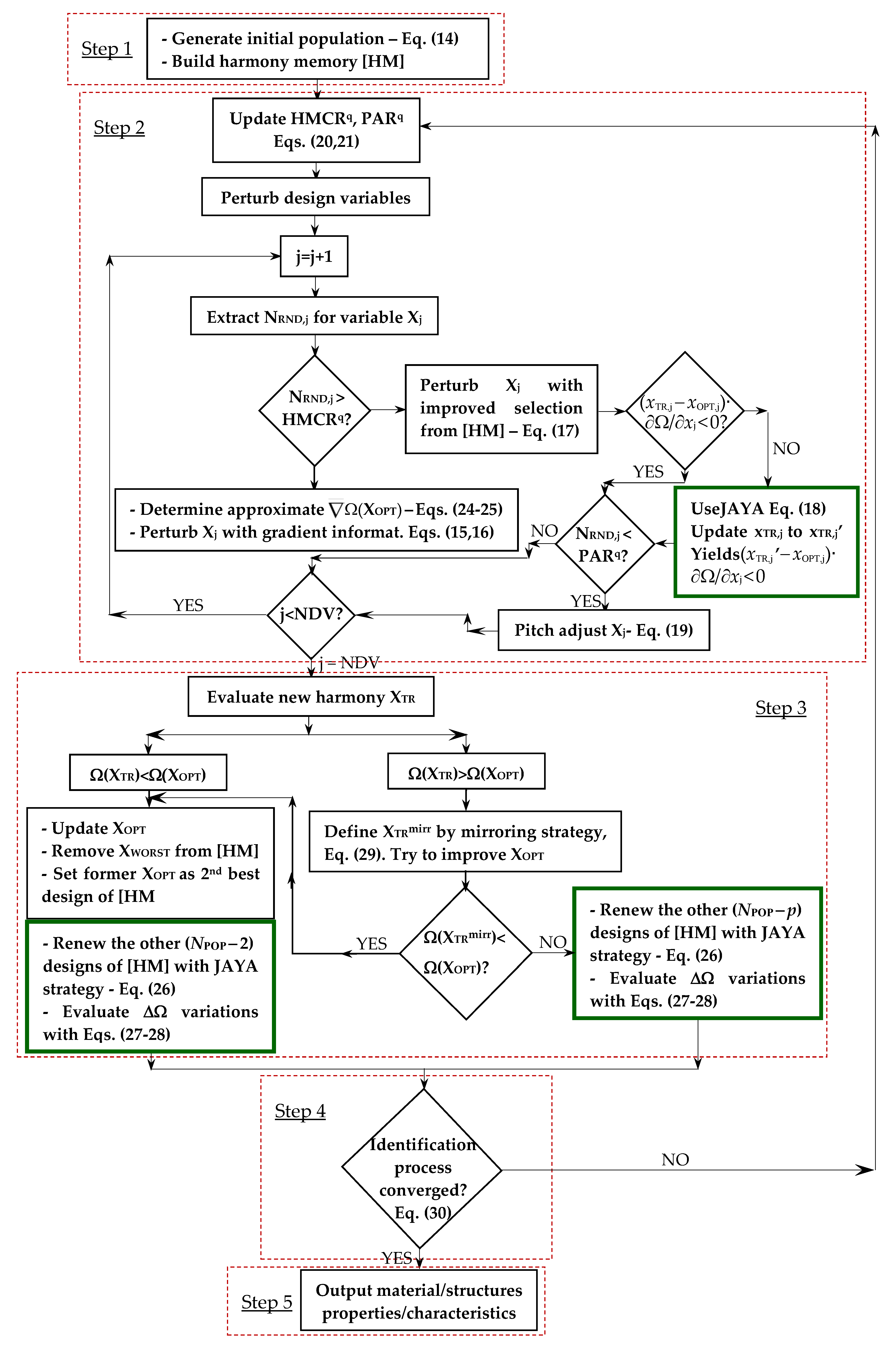
3.2.3. Step 3: Evaluation of XTR Trial Design and Population Update
Case 1: Ω(XTR) < WOPT
Case 2: Ω(XTR) > ΩOPT
3.2.4. Step 4: Convergence Check
3.2.5. Step 5: Termination of Optimization Process
3.3. Summary of HS–JAYA Algorithm and Discussion on Local Search Schemes in Metaheuristic Optimization
4. Results and Discussion
4.1. Outline of Experimental Measurements
4.2. IM Measurements and Preliminary Mechanical Characterization (Anisotropic Response)
4.3. Detailed Mechanical Characterization of the 100 mm Diameter Membrane
4.3.1. Measured Displacement Fields
4.3.2. Solution of the Inverse Problem: FE Analysis and Metaheuristic Optimization
5. Conclusions and Future Work
Author Contributions
Funding
Institutional Review Board Statement
Informed Consent Statement
Data Availability Statement
Acknowledgments
Conflicts of Interest
References
- Kavanagh, K.T.; Clough, R.W. Finite element applications in the characterization of elastic solids. Int. J. Solids Struct. 1971, 7, 11–23. [Google Scholar] [CrossRef]
- Marwala, T. Finite-Element Model Updating Using Computational Intelligence Techniques: Applications to Structural Dynamics; Springer: New York, NY, USA, 2010. [Google Scholar]
- Bruno, L. Mechanical characterization of composite materials by optical techniques: A review. Opt. Lasers Eng. 2018, 104, 192–203. [Google Scholar] [CrossRef]
- Martins, J.M.P.; Andrade-Campos, A.; Thuillier, S. Comparison of inverse identification strategies for constitutive mechanical models using full-field measurements. Int. J. Mech. Sci. 2018, 145, 330–345. [Google Scholar] [CrossRef]
- Pierron, F.; Grediac, M. Towards Material Testing 2.0. A review of test design for identification of constitutive parameters from full-field measurements. Strain 2020, 57, e12370. [Google Scholar] [CrossRef]
- Pierron, F.; Grediac, M. The Virtual Fields Method. Extracting Constitutive Mechanical Parameters from Full-Field Deformation Measurements; Springer: New York, NY, USA, 2012. [Google Scholar]
- Maier, G.; Giannessi, F.; Nappi, A. Identification of yield limits by mathematical programming. Eng. Struct. 1982, 4, 86–98. [Google Scholar] [CrossRef]
- Bittanti, S.; Maier, G.; Nappi, A. Inverse problems in structural elasto-plasticity: A Kalman filter approach. In Plasticity Today; Sawczuk, A., Bianchi, G., Eds.; Elsevier: London, UK, 1983; pp. 311–329. [Google Scholar]
- Bolzon, G.; Maier, G.; Panico, M. Material model calibration by indentation, imprint mapping and inverse analysis. Int. J. Solids Struct. 2004, 41, 2957–2975. [Google Scholar] [CrossRef]
- Bolzon, G.; Buljak, V.; Maier, G.; Miller, B. Assessment of elastic–plastic material parameters comparatively by three procedures based on indentation test and inverse analysis. Inverse Probl. Sci. Eng. 2011, 19, 815–837. [Google Scholar] [CrossRef]
- Buljak, V.; Bocciarelli, M.; Maier, G. Mechanical characterization of anisotropic elasto-plastic materials by indentation curves only. Meccanica 2014, 49, 1587–1599. [Google Scholar] [CrossRef]
- Buljak, V.; Cocchetti, G.; Cornaggia, A.; Maier, G. Parameter identification in elastoplastic material models by Small Punch Tests and inverse analysis with model reduction. Meccanica 2018, 53, 3815–3829. [Google Scholar] [CrossRef]
- Fedele, R.; Maier, G.; Whelan, M. Stochastic calibration of local constitutive models through measurements at the macroscale in heterogeneous media. Comput. Methods Appl. Mech. Eng. 2006, 195, 4971–4990. [Google Scholar] [CrossRef]
- Bocciarelli, M.; Bolzon, G.; Maier, G. A constitutive model of metal–ceramic functionally graded material behavior: Formulation and parameter identification. Comput. Mater. Sci. 2008, 43, 16–26. [Google Scholar] [CrossRef]
- Bocciarelli, M.; Maier, G. Indentation and imprint mapping method for identification of residual stresses. Comput. Mater. Sci. 2007, 39, 381–392. [Google Scholar] [CrossRef]
- Fedele, R.; Filippini, M.; Maier, G. Constitutive model calibration for railway wheel steel through tension–torsion tests. Comput. Struct. 2005, 83, 1005–1020. [Google Scholar] [CrossRef]
- Maier, G.; Bocciarelli, M.; Bolzon, G.; Fedele, R. Inverse analyses in fracture mechanics. Int. J. Fract. 2006, 138, 47–73. [Google Scholar] [CrossRef]
- Maier, G.; Buljak, V.; Garbowski, T.; Cocchetti, G.; Novat, G. Mechanical characterization of materials and diagnosis of structures by inverse analyses: Some innovative procedures and applications. Int. J. Comput. Methods 2014, 11, 1343002. [Google Scholar] [CrossRef]
- Ageno, M.; Bolzon, G.; Maier, G. An inverse analysis procedure for the material parameter identification of elastic–plastic free-standing foils. Struct. Multidiscip. Optim. 2009, 38, 229–243. [Google Scholar] [CrossRef]
- Garbowski, T.; Maier, G.; Novati, G. On calibration of orthotropic elastic-plastic constitutive models for paper foils by biaxial tests and inverse analyses. Struct. Multidiscip. Optim. 2012, 46, 111–128. [Google Scholar] [CrossRef]
- Cocchetti, G.; Mahini, M.R.; Maier, G. Mechanical characterization of foils with compression in their planes. Mech. Adv. Mater. Struct. 2014, 21, 853–870. [Google Scholar] [CrossRef]
- Gajewski, T.; Garbowski, T. Calibration of concrete parameters based on digital image correlation and inverse analysis. Arch. Civ. Mech. Eng. 2014, 14, 170–180. [Google Scholar] [CrossRef]
- Chuda-Kowalska, M.; Gajewski, T.; Garbowski, T. Mechanical characterization of orthotropic elastic parameters of a foam by the mixed experimental-numerical analysis. J. Theor. Appl. Mech. 2015, 53, 383–394. [Google Scholar] [CrossRef]
- Buljak, V. Inverse Analyses with Model Reduction: Proper Orthogonal Decomposition in Structural Mechanics; Springer: Berlin/Heidelberg, Germany, 2012. [Google Scholar]
- Wolpert, D.H.; Macready, W.G. No Free Lunch Theorems for optimization. IEEE Trans. Evol. Comput. 1997, 1, 67–82. [Google Scholar] [CrossRef]
- Ho, Y.C.; Pepyne, D.L. Simple explanation of the No-Free-Lunch Theorem and its implications. J. Optim. Theory Appl. 2002, 115, 549–570. [Google Scholar] [CrossRef]
- Ficarella, E.; Lamberti, L.; Degertekin, S.O. Mechanical identification of materials and structures with optical methods and metaheuristic optimization. Materials 2019, 12, 2133. [Google Scholar] [CrossRef] [PubMed]
- Gallet, A.; Rigby, S.; Tallman, T.N.; Kong, X.; Hajirasouliha, A.; Liew, A.; Liu, D.; Chen, L.; Hauptmann, A.; Smyl, D. Structural engineering from an inverse problem perspective. Proc. R. Soc. A 2022, 478, 20210526. [Google Scholar] [CrossRef]
- Mansouri, M.R.; Darijani, H.; Baghani, M. On the correlation of FEM and experiments for hyperelastic elastomers. Exp. Mech. 2017, 57, 195–206. [Google Scholar] [CrossRef]
- Sciammarella, C.A. Overview of optical techniques that measure displacements. Murray Lecture. Exp. Mec. 2003, 43, 1–19. [Google Scholar] [CrossRef]
- Sciammarella, C.A.; Sciammarella, F.M. Experimental Mechanics of Solids; Wiley: Chichester, UK, 2012. [Google Scholar]
- Sciammarella, C.A. A review: Optical methods that measure displacement. In Advancement of Optical Methods & Digital Image Correlation in Experimental Mechanics, Proceedings of the 2018 Annual Conference on Experimental and Applied Mechanics; Lamberti, L., Furlong, C., Lin, M.T., Sciammarella, C.A., Reu, P.L., Sutton, M.A., Eds.; Springer: New York, NY, USA, 2019; Volume 3, Chapter 3; pp. 23–52. [Google Scholar]
- Cloud, G.L. Optical Methods of Engineering Analysis; Cambridge University Press: New York, NY, USA, 1998. [Google Scholar]
- Cosola, E.; Genovese, K.; Lamberti, L.; Pappalettere, C. A general framework for identification of hyper-elastic membranes with moiré techniques and multi-point simulated annealing. Int. J. Solids Struct. 2008, 45, 6074–6099. [Google Scholar] [CrossRef]
- Sciammarella, C.A.; Lamberti, L.; Boccaccio, A. General model for moiré contouring, part 1: Theory. Opt. Eng. 2008, 47, 033605. [Google Scholar] [CrossRef]
- Sciammarella, C.A.; Lamberti, L.; Boccaccio, A.; Cosola, E.; Posa, D. General model for moiré contouring, part 2: Applications. Opt. Eng. 2008, 47, 033606. [Google Scholar] [CrossRef]
- Elouneg, A.; Sutula, D.; Chambert, J.; Lejeune, A.; Bordas, S.P.A.; Jacquet, E. An open-source FEniCS-based framework for hyperelastic parameter estimation from noisy full-field data: Application to heterogeneous soft tissues. Comput. Struct. 2021, 255, 106620. [Google Scholar] [CrossRef]
- Borzeszkowski, B.; Lubowiecka, I.; Sauer, R.A. Nonlinear material identification of heterogeneous isogeometric Kirchhoff–Love shells. Comput. Methods Appl. Mech. Eng. 2022, 390, 114442. [Google Scholar] [CrossRef]
- Wineman, A.; Wilson, D.; Melvin, J.W. Material identification of soft tissue using membrane inflation. J. Biomech. 1979, 12, 841–850. [Google Scholar] [CrossRef] [PubMed]
- Sacks, M.S. Biaxial mechanical evaluation of planar biological materials. J. Elast. 2000, 61, 199–246. [Google Scholar] [CrossRef]
- Bersi, M.; Bellini, C.; Di Achille, P.; Humphrey, J.D.; Genovese, K.; Avril, S. Novel methodology for characterizing regional variations in material properties of murine aortas. J. Biomech. Eng. 2016, 138, 0710051–07100515. [Google Scholar] [CrossRef]
- Genovese, K. An omnidirectional DIC system for dynamic strain measurement on soft biological tissues and organs. Opt. Lasers Eng. 2019, 116, 6–18. [Google Scholar] [CrossRef]
- Wimmer, M.; Ertl, P.; Schneider, J.; Abraham, F. Equibiaxial tension testing of rubber on a universal tension-testing machine. In Constitutive Models for Rubber XI, 1st ed.; Huneau, B., Le Cam, J.B., Marco, Y., Verron, E., Eds.; CRC Press: London, UK, 2019; Chapter 7; pp. 1–7. [Google Scholar]
- Shabbir, S.; Satyanarayana, B.; Sreeramulu, K. Characterization of hyperelastic material by experimental tests and curve fitting. Mater. Today Proc. 2020, 24, 1670–1679. [Google Scholar] [CrossRef]
- Genovese, K.; Badel, P.; Cavinato, C.; Pierrat, B.; Bersi, M.R.; Avril, S.; Humphrey, J.D. Multi-view digital image correlation system for in vitro testing of arteries from mice to humans. Exp. Mech. 2021, 61, 1455–1472. [Google Scholar] [CrossRef]
- Pearce, D.; Nemcek, M.; Witzenburg, C. Combining unique planar biaxial testing with full-field thickness and displacement measurement for spatial characterization of soft tissues. Curr. Protoc. 2022, 2, e493. [Google Scholar] [CrossRef]
- Timoshenko, S.P.; Woinowsky-Kreiger, S. Theory of Plates and Shells; McGraw-Hill: New York, NY, USA, 1964. [Google Scholar]
- Niordson, F.I. Shell Theory; Elsevier: Amsterdam, The Netherlands, 2012. [Google Scholar]
- Mott, P.H.; Roland, C.M.; Hassan, S.E. Strains in an inflated rubber sheet. Rubber Chem. Technol. 2003, 76, 326–333. [Google Scholar] [CrossRef]
- Geem, Z.W.; Kim, J.H.; Loganathan, G. A new heuristic optimization algorithm: Harmony search. Simulation 2001, 76, 60–68. [Google Scholar] [CrossRef]
- Lee, K.S.; Geem, Z.W. A new meta-heuristic algorithm for continuous engineering optimization: Harmony search theory and practice. Comput. Methods Appl. Mech. Eng. 2005, 194, 3902–3933. [Google Scholar] [CrossRef]
- Rao, R.V. Jaya: A simple and new optimization algorithm for solving constrained and unconstrained optimization problems. Int. J. Ind. Eng. Comput. 2016, 7, 19–34. [Google Scholar]
- Carbas, S.; Saka, M.P. Optimum topology design of various geometrically nonlinear latticed domes using improved harmony search method. Struct. Multidiscip. Optim. 2012, 45, 377–399. [Google Scholar] [CrossRef]
- Degertekin, S.O.; Minooei, M.; Santoro, L.; Trentadue, B.; Lamberti, L. Large-scale truss-sizing optimization with enhanced hybrid HS algorithm. Appl. Sci. 2021, 11, 3270. [Google Scholar] [CrossRef]
- Fesanghary, M.; Mahdavi, M.; Minary-Jolandan, M.; Alizadeh, Y. Hybridizing harmony search algorithm with sequential quadratic programming for engineering optimization problems. Comput. Methods Appl. Mech. Eng. 2008, 197, 3080–3091. [Google Scholar] [CrossRef]
- Hwang, S.F.; He, R.S. Improving real-parameter genetic algorithm with simulated annealing for engineering problems. Adv. Eng. Softw. 2006, 37, 406–418. [Google Scholar] [CrossRef]
- Bao, Y.; Hu, Z.; Xiong, T. A PSO and pattern search based memetic algorithm for SVMs parameters optimization. Neurocomputing 2013, 117, 98–106. [Google Scholar] [CrossRef]
- Tahereh Abbasi-khazaei, T.; Rezvani, M.H. Energy-aware and carbon-efficient VM placement optimization in cloud datacenters using evolutionary computing methods. Soft Comput. 2022, 26, 9287–9322. [Google Scholar] [CrossRef]
- Mooney, M. A theory of large elastic deformation. J. Appl. Phys. 1940, 11, 582–592. [Google Scholar] [CrossRef]
- Rivlin, R.S. Large elastic deformations of isotropic materials. I. Fundamental concepts. Philos. Trans. R. Soc. Lond. A 1948, 240, 459–490. [Google Scholar]
- Rivlin, R.S. Large elastic deformations of isotropic materials. IV. Further developments of the general theory. Philos. Trans. R. Soc. Lond. A 1948, 241, 379–397. [Google Scholar]
- Ogden, R.W. Non-Linear Elastic Deformations; Dover: Mineola, NY, USA, 1997. [Google Scholar]
- Brunelli, R.; De Spirito, M.; Giancotti, A.; Palmieri, V.; Parasassi, T.; Di Mascio, D.; Flammini, G.; D’Ambrosio, V.; Monti, M.; Boccaccio, A.; et al. The biomechanics of the umbilical cord Wharton Jelly: Roles in hemodynamic proficiency and resistance to compression. J. Mech. Behav. Biomed. Mater. 2019, 100, 103377. [Google Scholar] [CrossRef] [PubMed]
- Javořik, J.; Dvořàk, Z. Equibiaxal test of elastomers. KGK Rubberpoint 2007, 608–610. [Google Scholar]
- Fayad, S.S.; Jones, E.M.C.; Seidl, D.T.; Reu, P.L.; Lambros, J. On the importance of direct-levelling for constitutive material model calibration using digital image correlation and finite element model updating. Exp. Mech. 2023, 63, 467–484. [Google Scholar] [CrossRef]
- Bastos, G.; Sales, L.; Di Cesare, N.; Tayeb, A.; Le Cam, J.B. Inverse-Pagerank-particle swarm optimisation for inverse identification of hyperelasticmodels: A feasibility study. J. Rubber Res. 2021, 24, 447–460. [Google Scholar] [CrossRef]
- Dya, T.; Blaise, B.B.; Betchewe, G.; Alidou, M. Implementation of particle swarm optimization algorithm in Matlab code for hyperelastic characterization. World J. Mech. 2021, 11, 146–163. [Google Scholar] [CrossRef]
- Kulcu, I.D. A hyperelastic constitutive model for rubber-like materials. Arch. Appl. Mech. 2020, 90, 615–622. [Google Scholar] [CrossRef]
- Bien-aimé, L.K.M.; Blaise, B.B.; Beda, T. Characterization of hyperelastic deformation behavior of rubber-like materials. SN Appl. Sci. 2020, 2, 648. [Google Scholar]
- Hou, J.; Lu, X.; Zhang, K.; Jing, Y.; Zhang, Z.; You, J.; Li, Q. Parameters identification of rubber-like hyperelastic material based on general regression neural network. Materials 2022, 15, 3776. [Google Scholar] [CrossRef]
- Yenigun, B.; Gkouti, E.; Barbaraci, G.; Czekanski, A. Identification of hyperelastic material parameters of elastomers by reverse engineering approach. Materials 2022, 15, 8810. [Google Scholar] [CrossRef]
- Yuan, Z.; Niu, M.-Q.; Ma, H.; Gao, T.; Zang, J.; Zhang, Y.; Chen, L.-Q. Predicting mechanical behaviors of rubber materials with artificial neural networks. Int. J. Mech. Sci. 2023, 249, 108265. [Google Scholar] [CrossRef]
- Tobajas, R.; Elduque, D.; Ibarz, E.; Javierre, C.; Canteli, A.F.; Gracia, L. Visco-hyperelastic model with damage for simulating cyclic thermoplastic elastomers behavior applied to an industrial component. Polymers 2018, 10, 668. [Google Scholar] [CrossRef]
- Tashiro, K.; Shobayashi, Y.; Ota, I.; Hotta, A. Finite element analysis of blood clots based on the nonlinear visco-hyperelastic model. Biophys. J. 2021, 120, 4547–4556. [Google Scholar] [CrossRef] [PubMed]
- Ficarella, E.; Minooei, M.; Santoro, L.; Toma, E.; Trentadue, B.; De Spirito, M.; Papi, M.; Pruncu, C.I.; Lamberti, L. Visco-hyperelastic characterization of the equine immature zona pellucida. Materials 2021, 14, 1223. [Google Scholar] [CrossRef] [PubMed]
- Mihai, L.A.; Chin, L.; Janmey, P.A.; Goriely, A. A comparison of hyperelastic constitutive models applicable to brain and fat tissues. J. R. Soc. Interface 2015, 12, 20150486. [Google Scholar] [CrossRef] [PubMed]
- Staber, B.; Guilleminot, J. Stochastic hyperelastic constitutive laws and identification procedure for soft biological tissues with intrinsic variability. J. Mech. Behav. Biomed. Mater. 2017, 65, 743–752. [Google Scholar] [CrossRef] [PubMed]
- Teferra, K.; Brewick, P.T. A Bayesian model calibration framework to evaluate brain tissue characterization experiments. Comput. Methods Appl. Mech. Eng. 2019, 357, 112604. [Google Scholar] [CrossRef]
- Estermann, S.J.; Pahr, D.H.; Reisinger, A. Hyperelastic and viscoelastic characterization of hepatic tissue under uniaxial tension in time and frequency domain. J. Mech. Behav. Biomed. Mater. 2020, 112, 104038. [Google Scholar] [CrossRef]
- Kenja, K.; Madireddy, S.; Vemaganti, K. Calibration of hyperelastic constitutive models: The role of boundary conditions, search algorithms, and experimental variability. Biomech. Model. Mechanobiol. 2020, 19, 1935–1952. [Google Scholar] [CrossRef]
- Dwivedi, K.K.; Lakhani, P.; Kumar, S.; Kumar, N. A hyperelastic model to capture the mechanical behaviour and histological aspects of the soft tissues. J. Mech. Behav. Biomed. Mater. 2022, 126, 105013. [Google Scholar] [CrossRef]
- Genovese, K.; Casaletto, L.; Humphrey, J.D.; Lu, J. Digital image correlation-based point-wise inverse characterization of heterogeneous material properties of gallbladder in vitro. Proc. R. Soc. A 2014, 470, 20140152. [Google Scholar] [CrossRef]
- Garcia, D.; Jones, M.E.; Zhu, Y.; Yu, H.Z. Mesoscale design of heterogeneous material systems in multi-material additive manufacturing. J. Mater. Res. 2018, 33, 58–67. [Google Scholar] [CrossRef]
- Deneweth, J.M.; Arruda, E.M.; McLean, S.G. Hyperelastic modeling of location-dependent human distal femoral cartilage mechanics. Int. J. Non Linear Mech. 2015, 68, 146–156. [Google Scholar] [CrossRef]
- Rivera, E.; Canales, C.; Pacheco, M.; García-Herrera, C.; Macías, D.; Celentano, D.J.; Herrera, E.A. Biomechanical characterization of the passive response of the thoracic aorta in chronic hypoxic newborn lambs using an evolutionary strategy. Sci. Rep. 2021, 11, 13875. [Google Scholar] [CrossRef]
- Canales, C.; García-Herrera, C.; Rivera, E.; Macías, D.; Celentano, D. Anisotropic hyperelastic material characterization: Stability criterion and inverse calibration with evolutionary strategies. Mathematics 2023, 11, 922. [Google Scholar] [CrossRef]
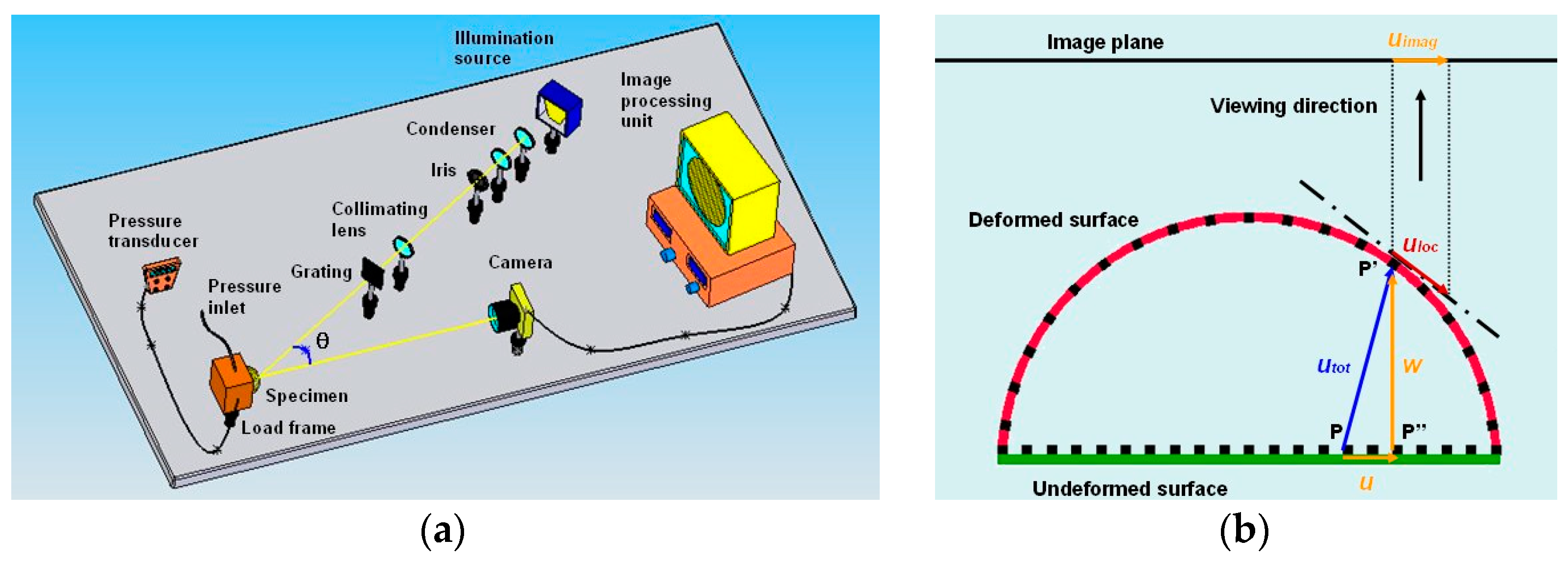
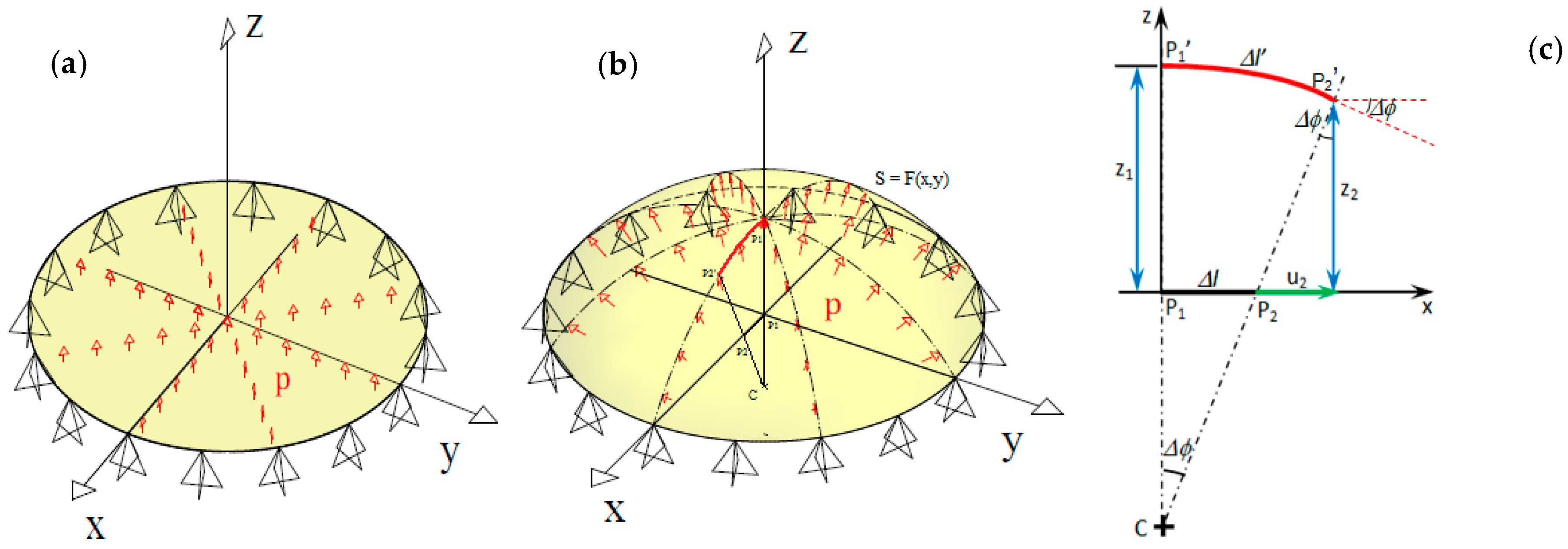
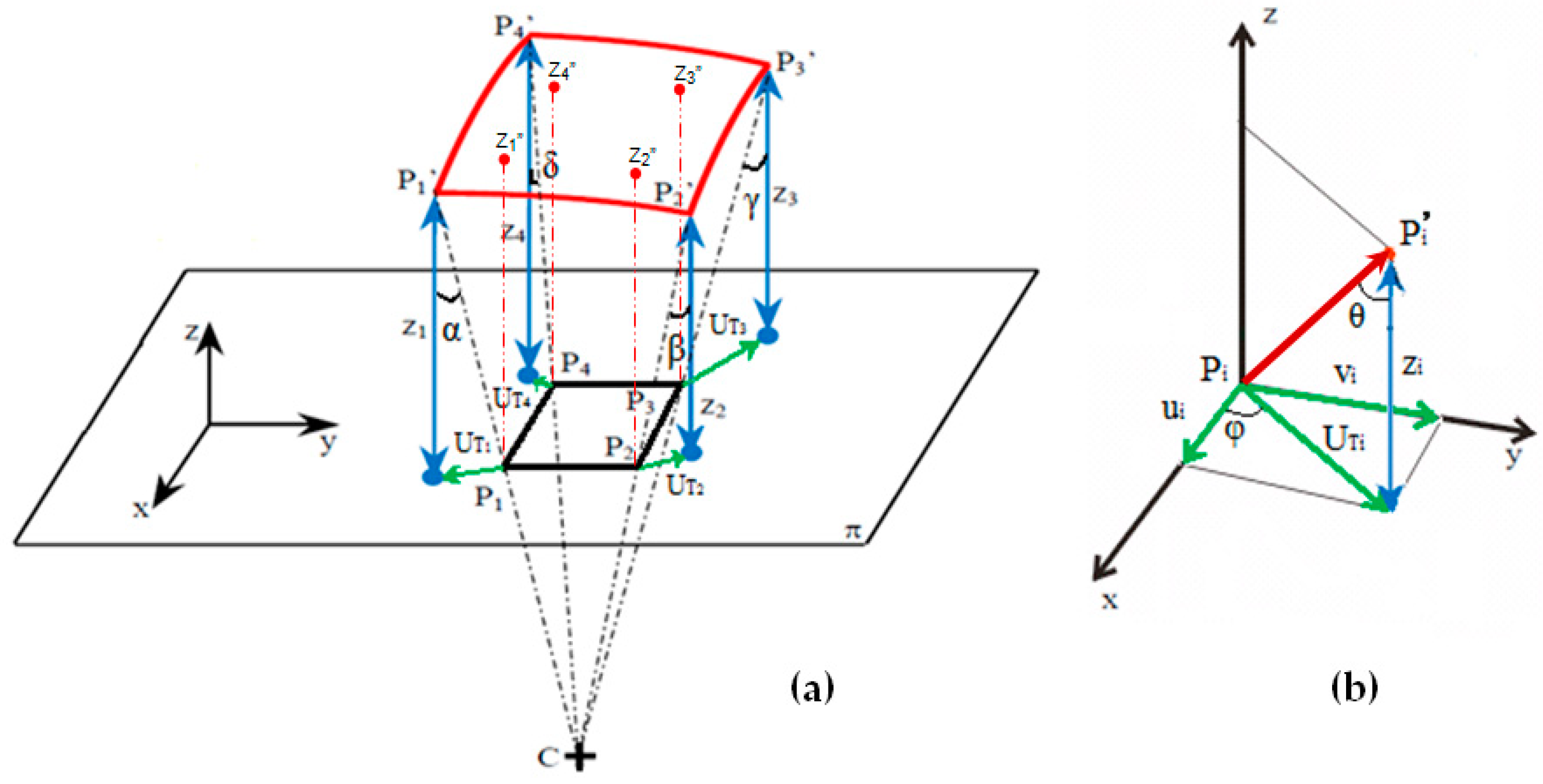

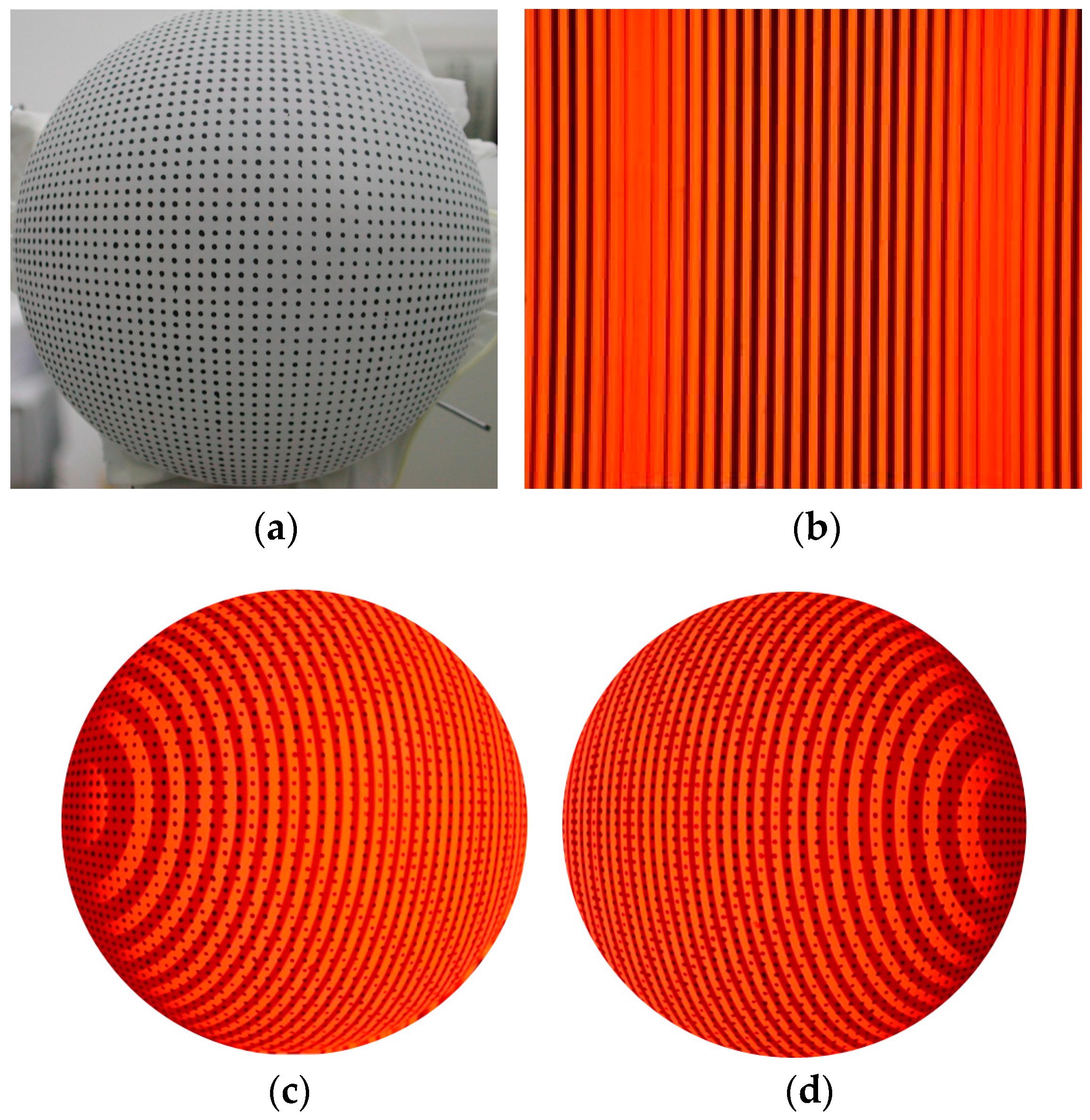

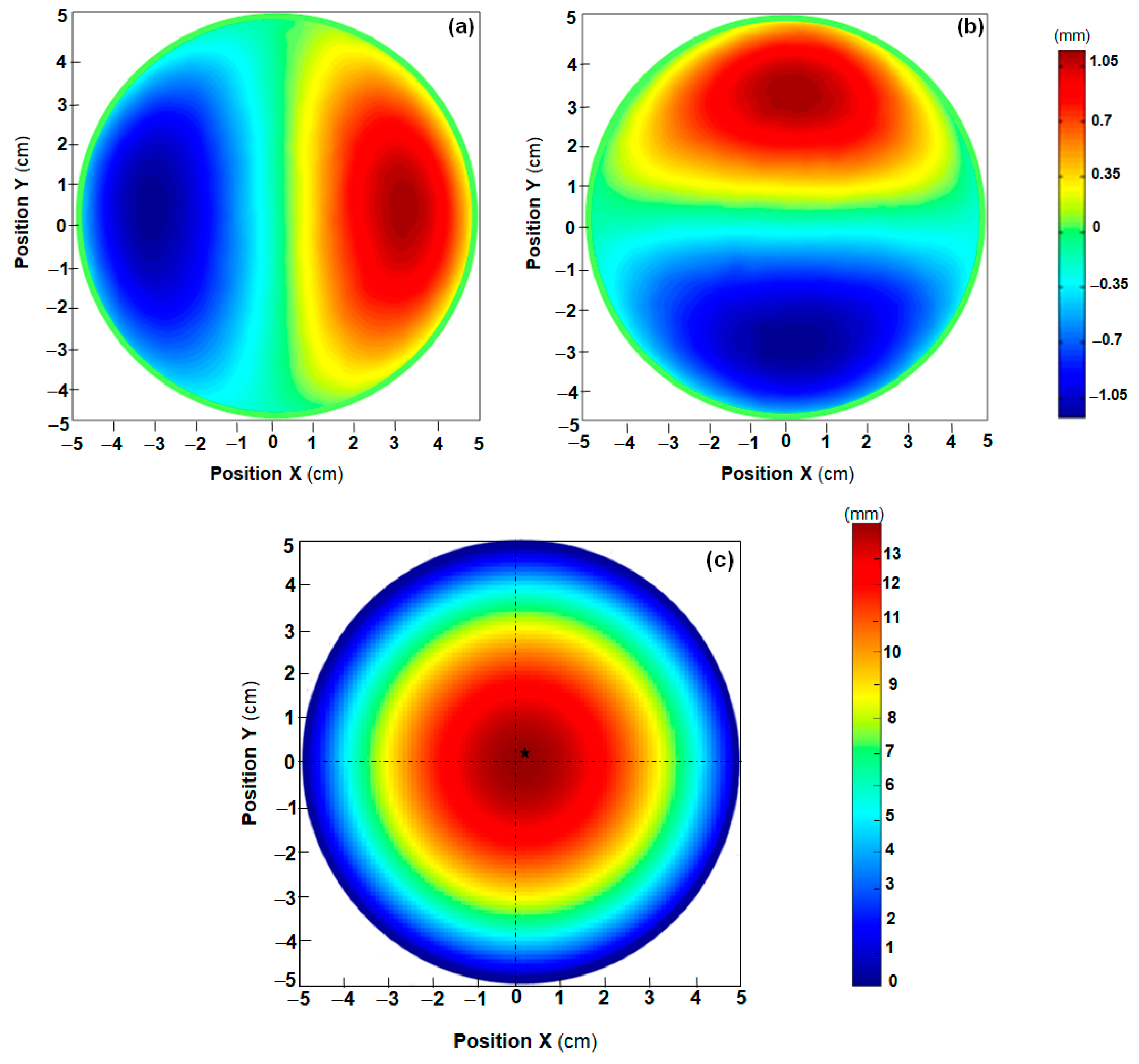
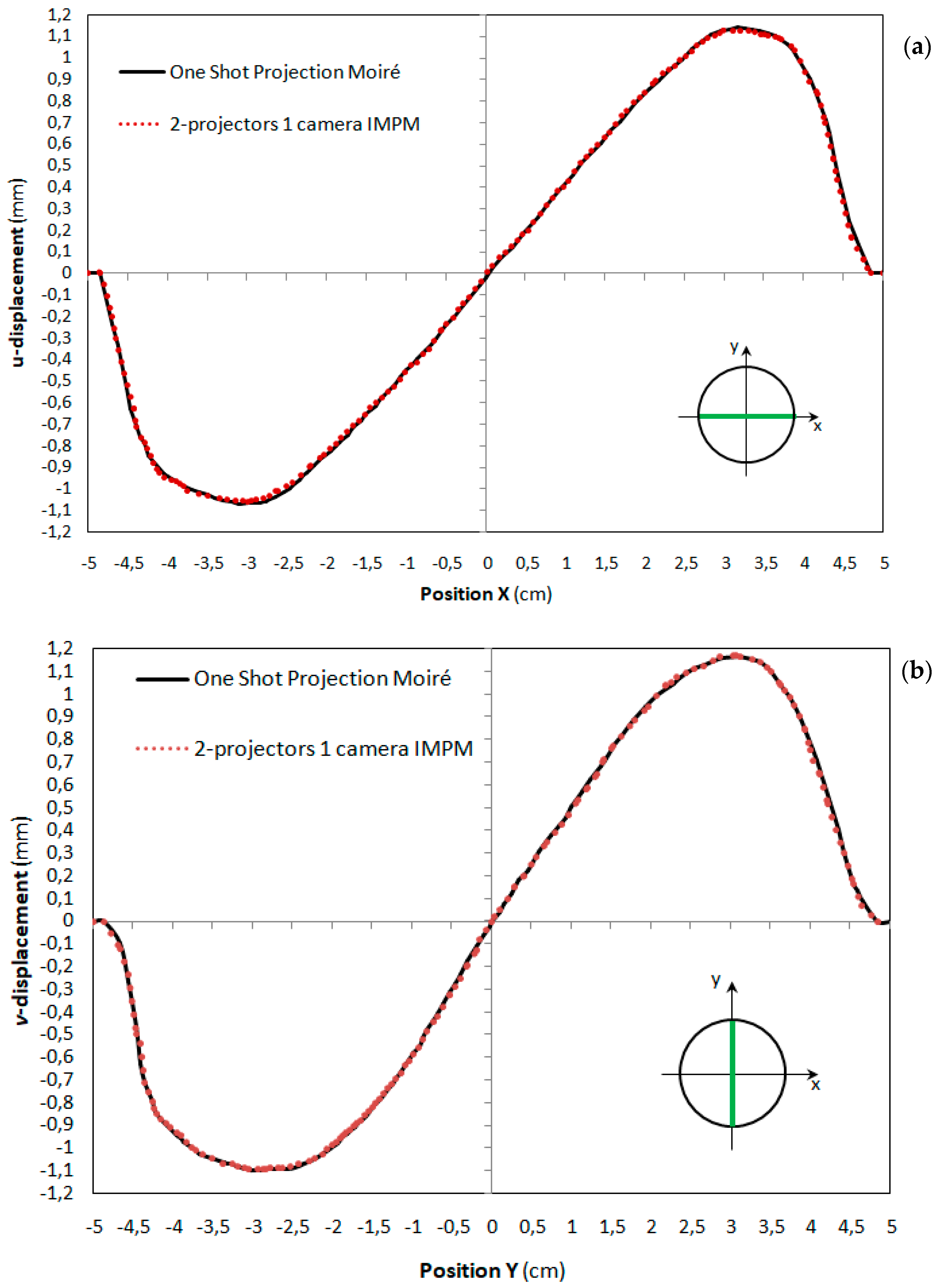

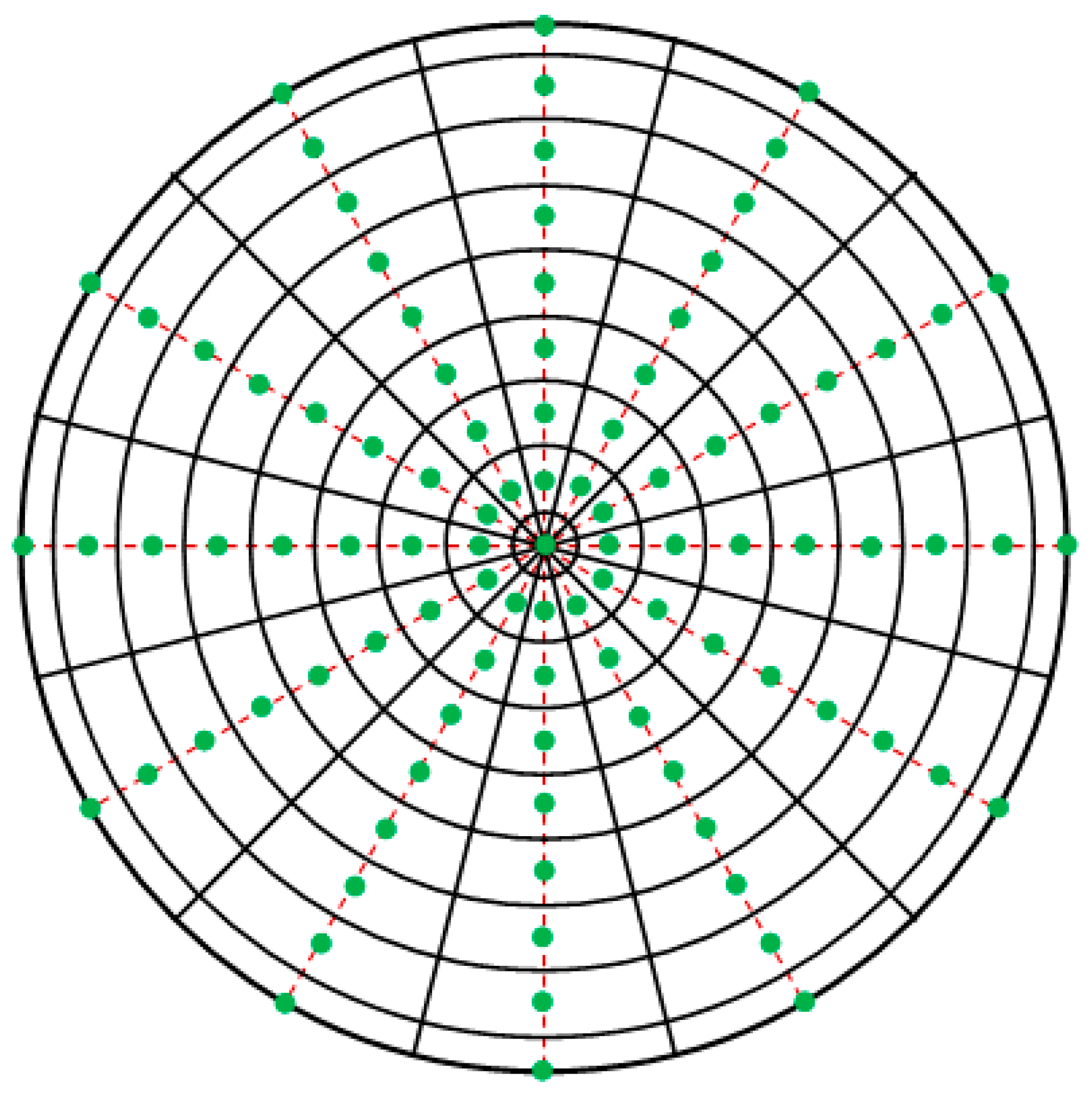
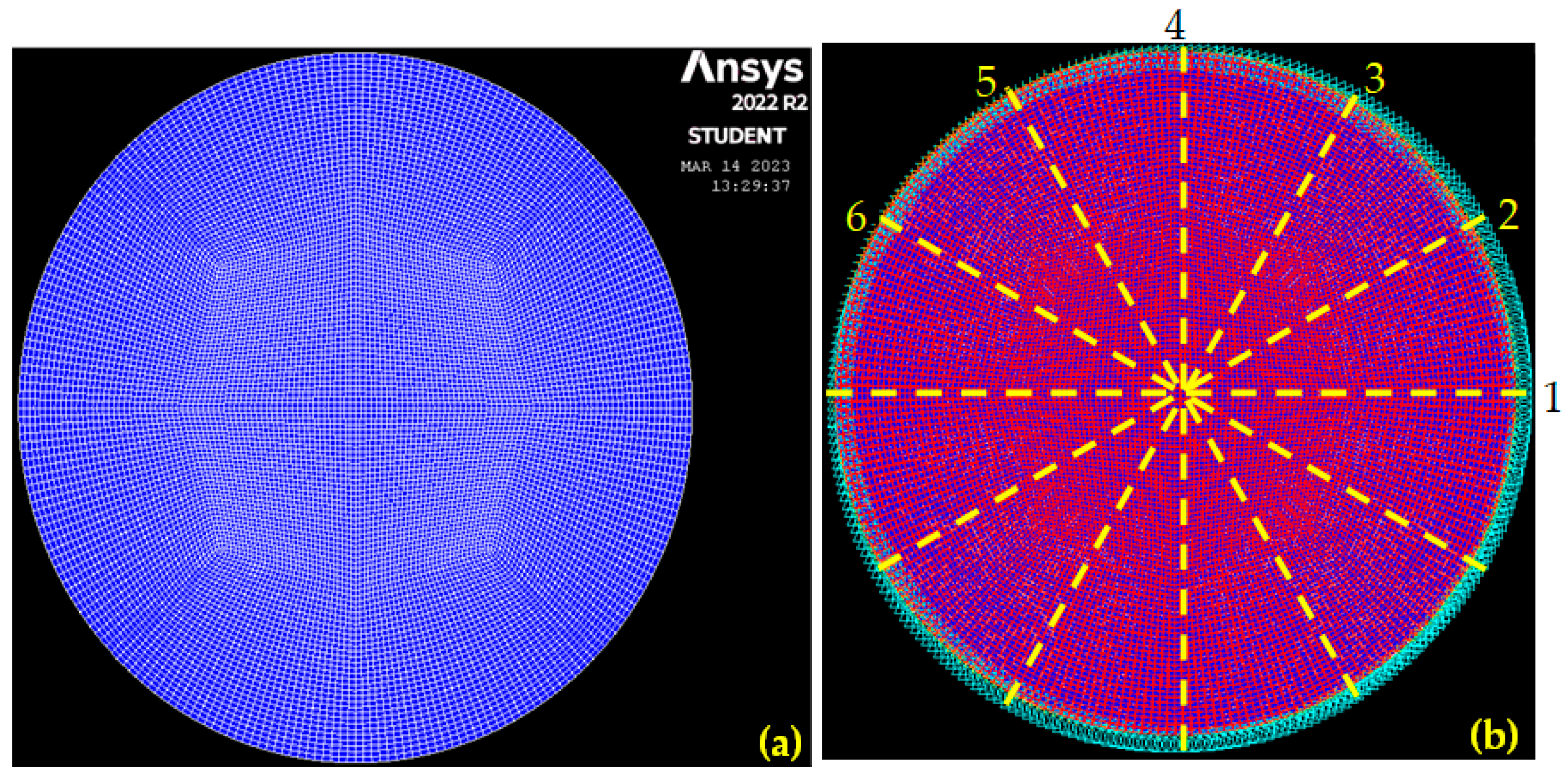

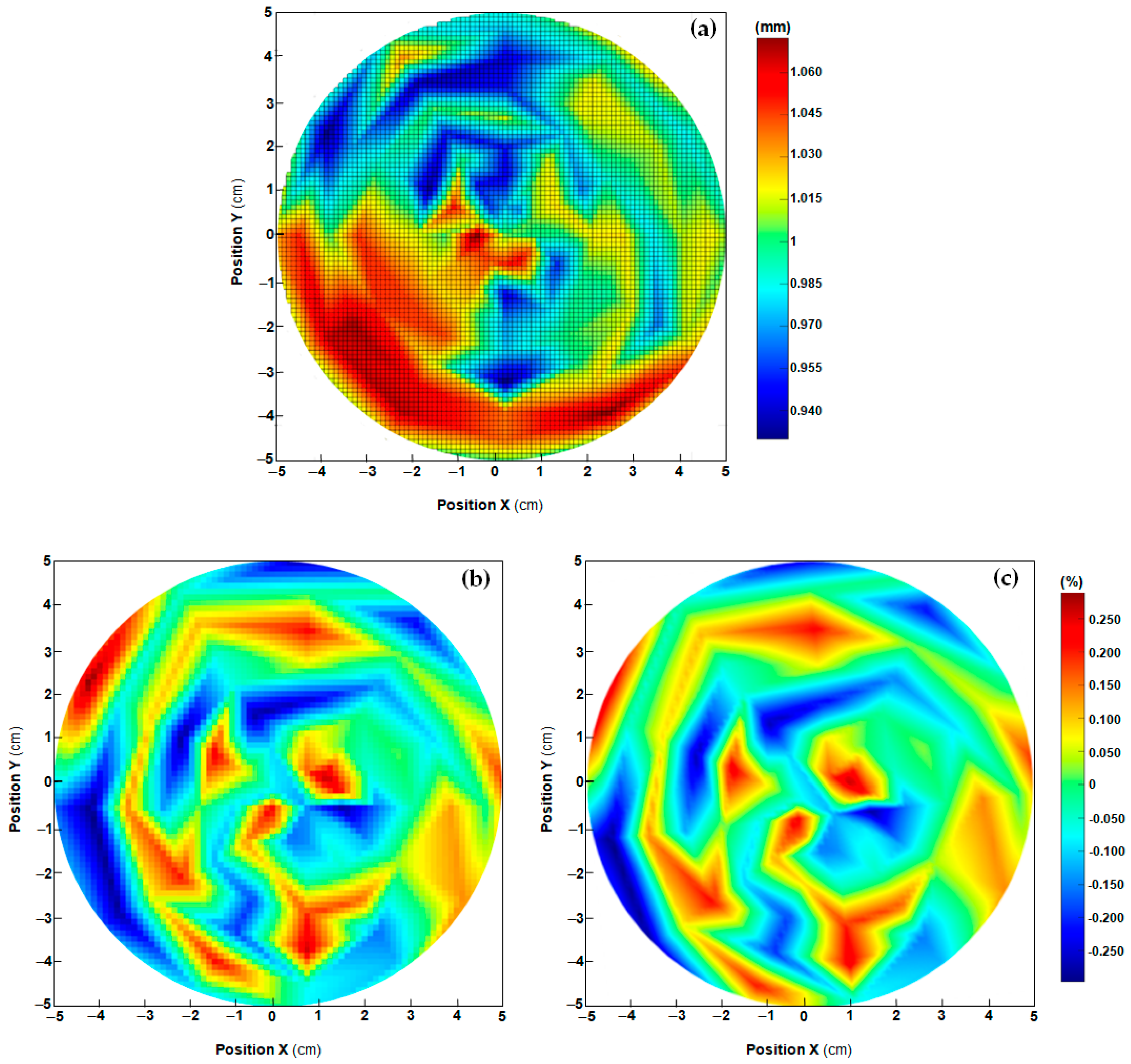
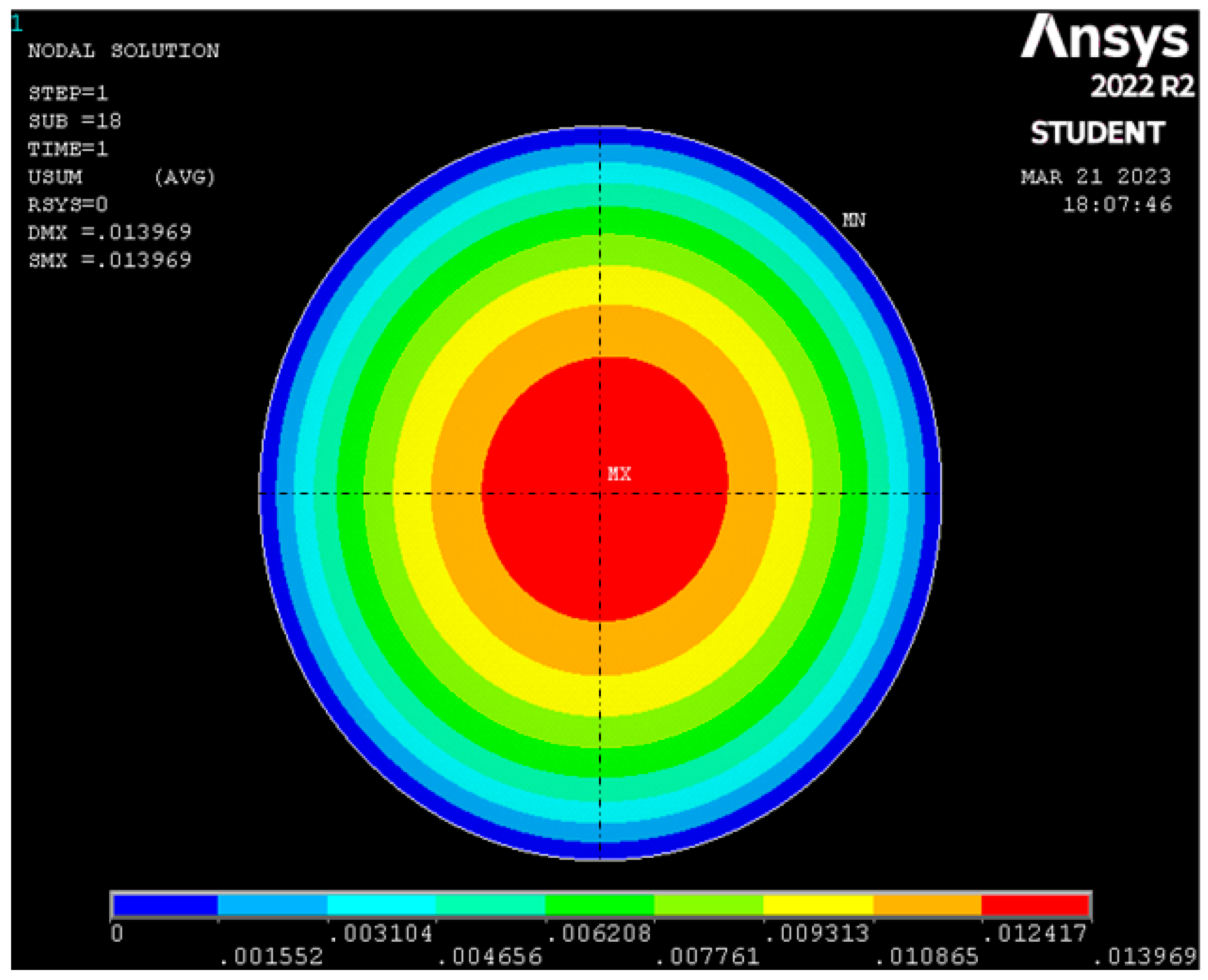
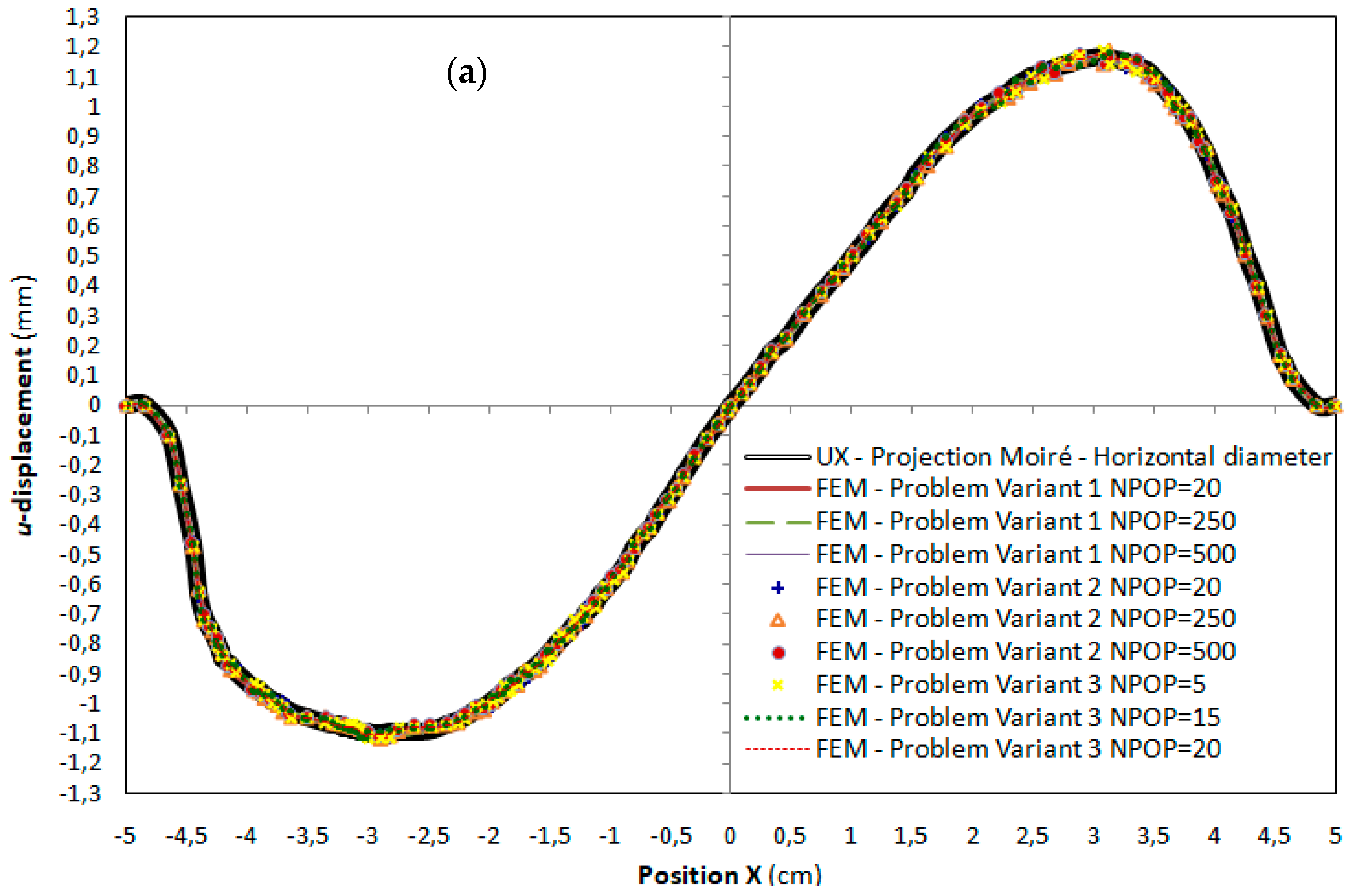
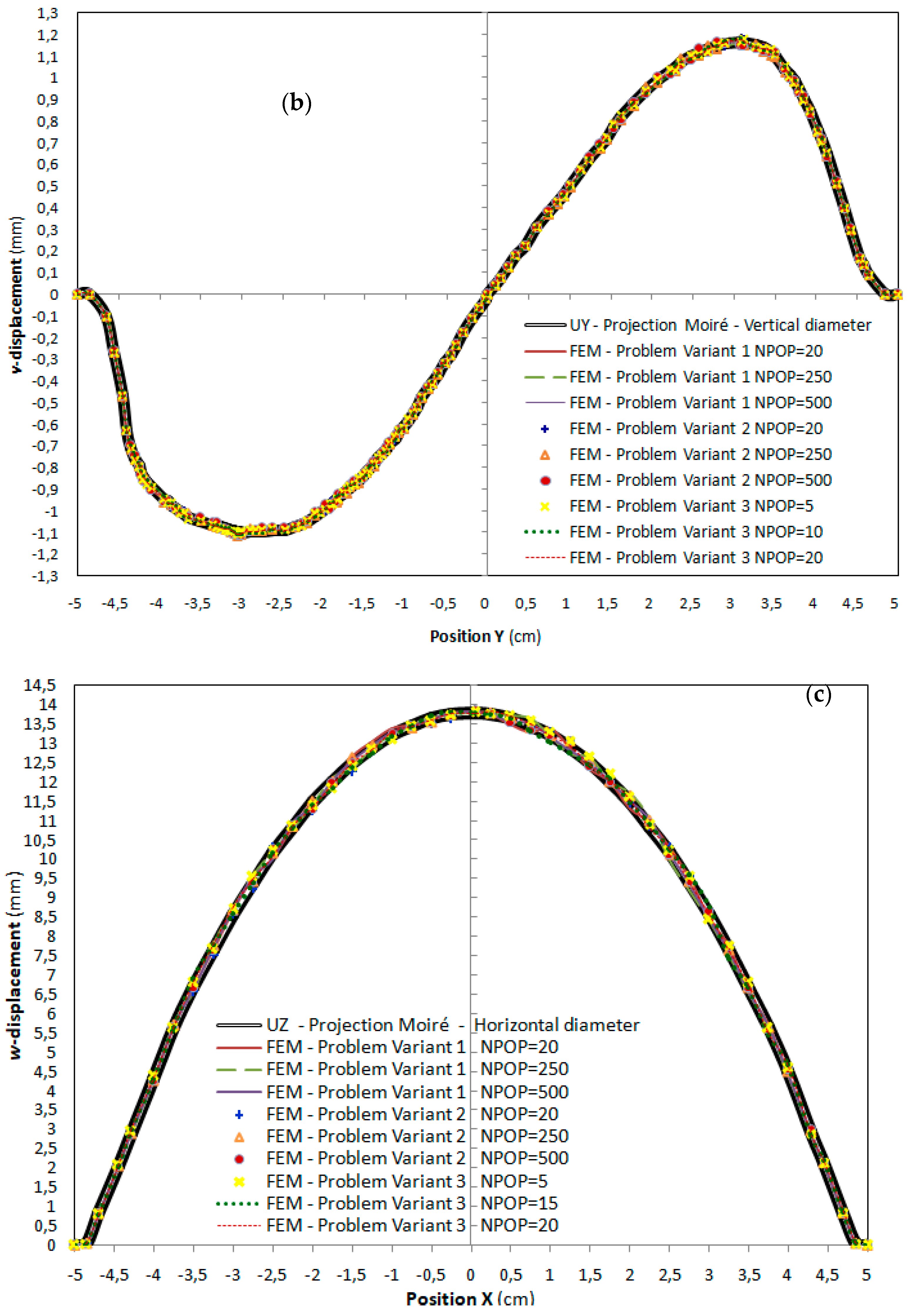
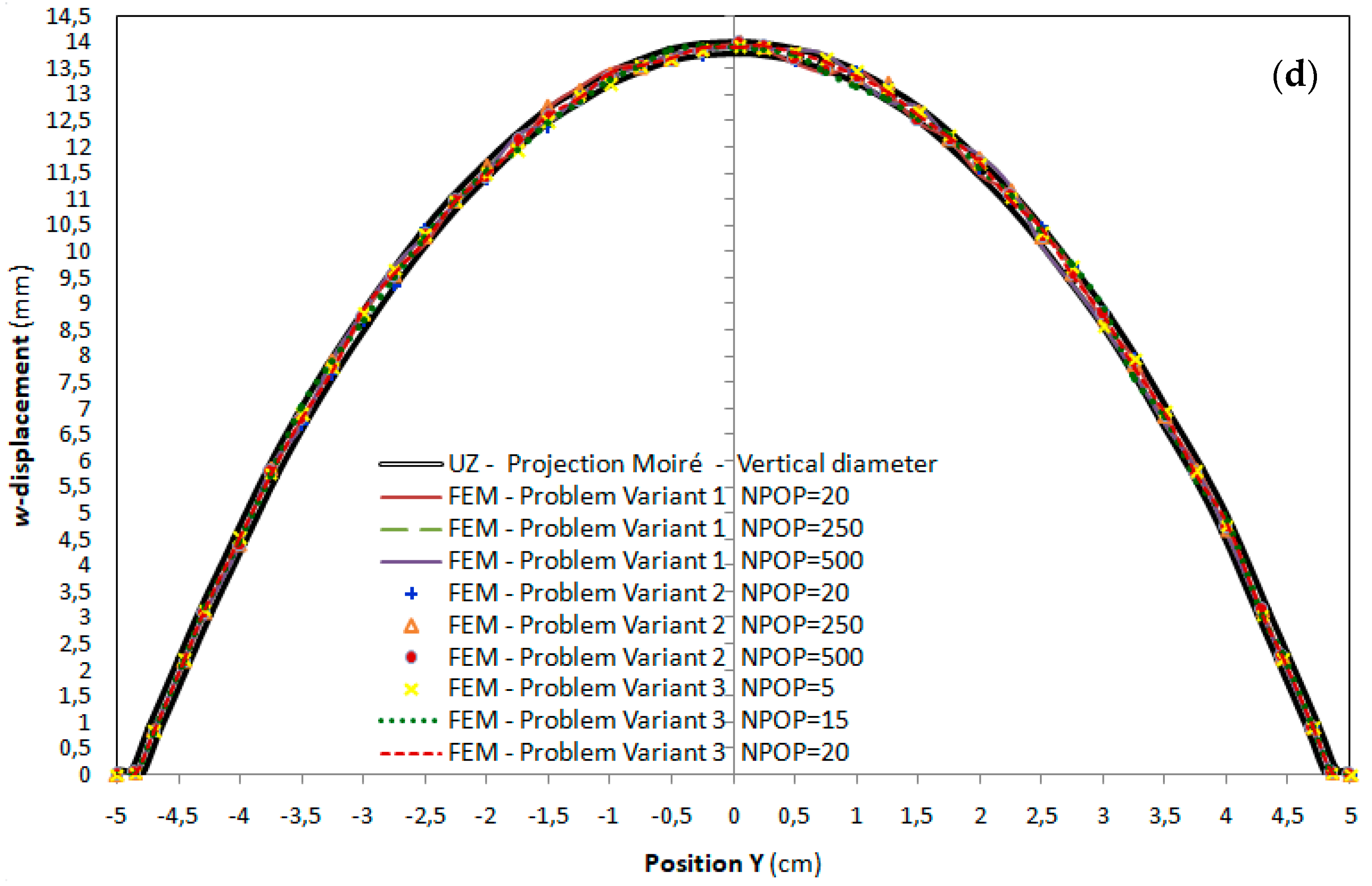
| Identified Properties | Problem Variant 1 | Problem Variant 2 | Problem Variant 3 |
|---|---|---|---|
| MR constants (kPa) | NPOP = 20 a10min 191.638 ± 1.642 a10max 213.086 ± 2.237 a01min 12.568 ± 0.124 a01max 13.834 ± 0.147 | NPOP = 20 a10 204.852 ± 2.089 a01 13.412 ± 0.137 | NPOP = 5 a10 203.763 ± 2.011 a01 13.279 ± 0.126 |
| NPOP = 250 a10min 191.727 ± 1.526 a10max 213.077 ± 2.146 a01min 12.675 ± 0.113 a01max 13.743 ± 0.145 | NPOP = 250 a10 204.819 ± 2.067 a01 13.356 ± 0.128 | NPOP = 10 a10 203.692 ± 1.989 a01 13.234 ± 0.117 | |
| NPOP = 500 a10min 191.563 ± 1.490 a10max 212.979 ± 2.129 a01min 12.497 ± 0.119 a01max 13.698 ± 0.146 | NPOP = 500 a10 204.833 ± 1.996 a01 13.387 ± 0.131 | NPOP = 20 a10 203.728 ± 2.004 a01 13.269 ± 0.122 | |
| Thickness (mm) | NPOP = 20 Min: 0.9288 ± 0.003037 Max: 1.0715 ± 0.003138 | NPOP = 20 0.9305 ± 0.003212 1.0728 ± 0.003387 | Min: 0.930 1 Max: 1.073 1 |
| NPOP = 250 Min: 0.9299 ± 0.003046 Max: 1.0726 ± 0.003154 | NPOP = 250 0.9301 ± 0.003209 1.0723 ± 0.003367 | ||
| NPOP = 500 Min: 0.9293 ± 0.003039 Max: 1.0719 ± 0.003127 | NPOP = 500 0.9307 ± 0.003204 1.0726 ± 0.003348 |
Disclaimer/Publisher’s Note: The statements, opinions and data contained in all publications are solely those of the individual author(s) and contributor(s) and not of MDPI and/or the editor(s). MDPI and/or the editor(s) disclaim responsibility for any injury to people or property resulting from any ideas, methods, instructions or products referred to in the content. |
© 2023 by the authors. Licensee MDPI, Basel, Switzerland. This article is an open access article distributed under the terms and conditions of the Creative Commons Attribution (CC BY) license (https://creativecommons.org/licenses/by/4.0/).
Share and Cite
Boccaccio, A.; Lamberti, L.; Santoro, L.; Trentadue, B. Mechanical Characterization of Soft Membranes with One-Shot Projection Moiré and Metaheuristic Optimization. Appl. Sci. 2023, 13, 7758. https://doi.org/10.3390/app13137758
Boccaccio A, Lamberti L, Santoro L, Trentadue B. Mechanical Characterization of Soft Membranes with One-Shot Projection Moiré and Metaheuristic Optimization. Applied Sciences. 2023; 13(13):7758. https://doi.org/10.3390/app13137758
Chicago/Turabian StyleBoccaccio, Antonio, Luciano Lamberti, Lorenzo Santoro, and Bartolomeo Trentadue. 2023. "Mechanical Characterization of Soft Membranes with One-Shot Projection Moiré and Metaheuristic Optimization" Applied Sciences 13, no. 13: 7758. https://doi.org/10.3390/app13137758
APA StyleBoccaccio, A., Lamberti, L., Santoro, L., & Trentadue, B. (2023). Mechanical Characterization of Soft Membranes with One-Shot Projection Moiré and Metaheuristic Optimization. Applied Sciences, 13(13), 7758. https://doi.org/10.3390/app13137758







